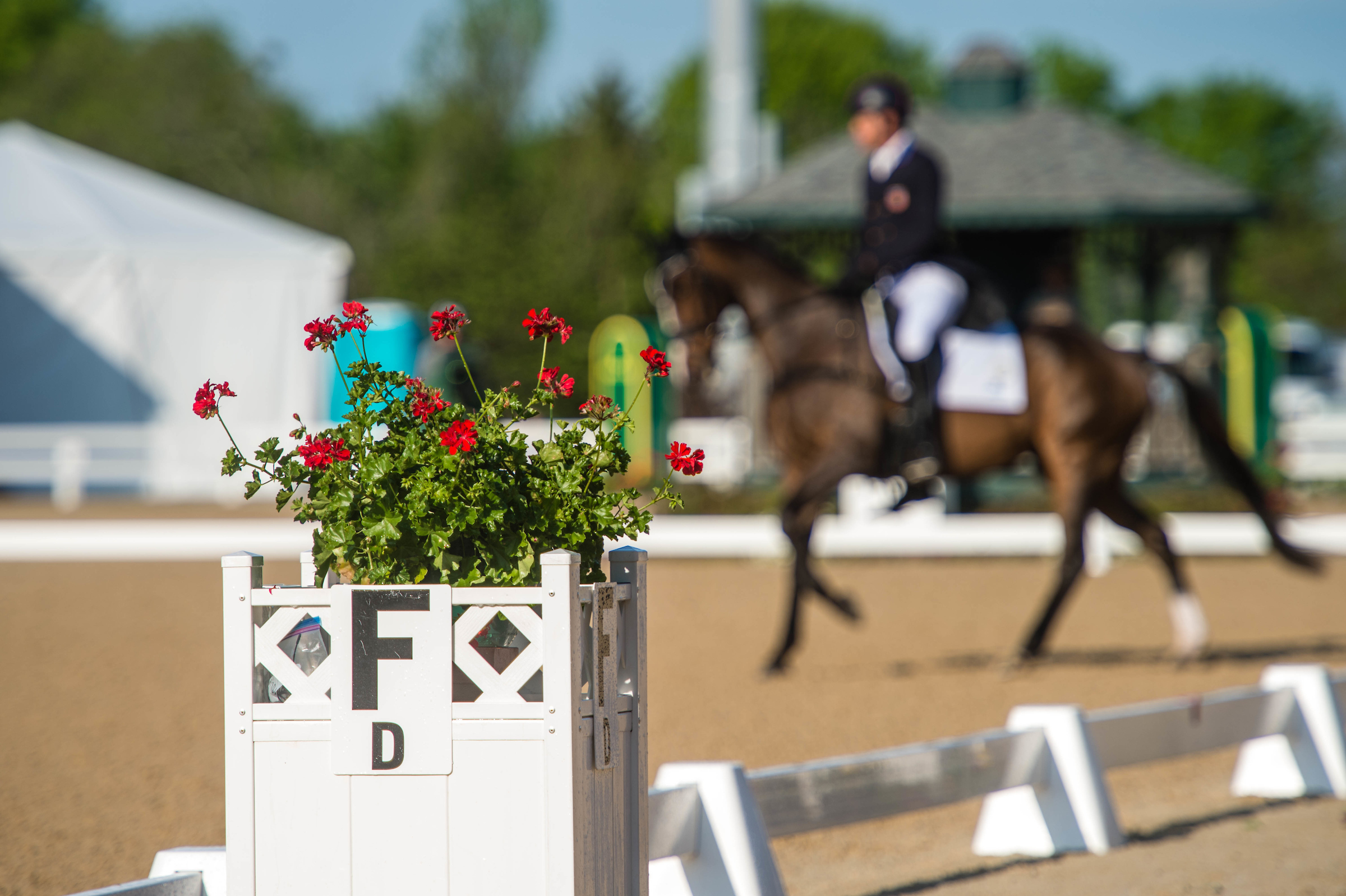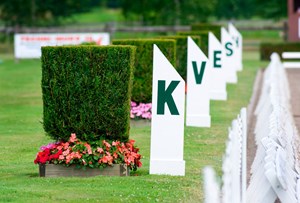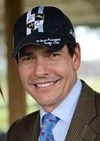As an FEI 3* judge, I see a lot of moments in the dressage competition arena where I wish I could just tell the rider, “You could correct that mistake by doing X and get an extra point.” Obviously, in the real world of judging, I cannot coach a rider at the precise moment help is needed. In the judge’s box, all I can do is provide helpful comments to the scribe, have faith in the legibility of her handwriting and hope the rider is able to review the test carefully and truly learn from it.
Certain fixes are more common than others, and I have compiled a list of 10 tips that I find myself wishing more competitors would keep in mind before heading down centerline. Try them out, and hopefully they will help you achieve higher scores and a better ride, and you will be happier for it—goals we all need in order to grow our sport.

1. Choose your test carefully. As an FEI competitor myself, I understand that we all want to progress through the levels and that each year we want to show in a more advanced level. Many times I hear a rider saying, “I must do ‘X’ level this year because I have been doing the same level for two years already.” However, I believe that the horses are the ones to tell us when it is the right time to move up and not the calendar. We have an obligation to listen to our horses.
It is always better to earn a good score in a lower level than a really bad one in a much more advanced level. Therefore, please choose the right level for you and your horse and be realistic about it by trusting your trainer, video and/or mirror (if you don’t have a trainer).
Use your judges’ scores to find out how you are doing at your current level. If your percentages are not more than 65 do not try to rush to the next level. Remember that in dressage, every step of training that you skip will force you to come back and redo it sooner or later.
I have always said that you should show at a level lower than what you are currently training. In this way you and your horse will be more confident and, therefore, more at ease and harmonious when showing, instead of you being worried about your capabilities at the competition. Within the level, ride the test that best shows off your horse’s talents, and only move up when you are ready. Judges would rather see a lower-level test beautifully ridden than a higher test badly performed.
2. Know your test by heart—study and visualize it. Once you have decided what level and which test you are riding, you really have to learn it. Do this with the help of your trainer. You can practice your test by visualizing it, by doing it on foot at home (or wherever you find it easiest for you) and by practicing the movements with your horse. I not only mean memorizing exactly what figures and movements you are going to perform, but also visualizing the way you are going to ride every single stride during your test. Knowing your test will lead to success in the ring because you can properly anticipate and prepare for the movements.

There are so many things that you have to do in a test that you must be able to ride it without even thinking what the next movement is going to be. Be truly prepared so you don’t waste energy on that. Use all your focus and mind to get a better performance instead of thinking whether you have to turn right or left or what is waiting for you on the next long side. If your memory sometimes plays a trick on you, it is OK to use a caller during your test, but do not rely on one.
I know there are a lot of discussions as to whether or not it is good to ride the test many times since many horses start anticipating transitions and movements. However, it is my opinion, especially for less-experienced riders and at lower levels, that if you practice the movements, then you will be much more confident when you enter the arena because you will know exactly how to prepare a transition or movement and how the horse will react to specific aids and, of course, what preparation is required.
3. Give a good impression as you circle the arena. Even though the rules state that what happens before you enter the arena at A cannot affect your score, usually the judges start looking at you before that. So ride to impress. Use this time to show the best you can of your horse and do not do inappropriate things like kick or jerk your hands because it does not give a good impression.
Also, even if you are feeling really scared, try to show confidence and smile. Try to have your horse on the aids, active and in the way you want to show him during your test, not more, not less. This is the first impression for the judge.
4. Master your entrance and halt. Even before you enter the arena, you must look where you are going. On the short side at A you must start focusing on the letter C and actually look into the eye of the judge who is usually exactly behind C. In this way you will find yourself on the centerline and not off to the side. Once you are on the centerline, start preparing your halt before you get to X, and do not just stop at X. It sounds simple, but time and time again, I see riders approach X with no preparation for the halt. The results are abrupt or unbalanced halts, and this, with practice and planning, can be so easily avoided.
For the halt movement’s required immobility and salute you have to consider how your horse is behaving on that particular day and anticipate how he will behave during the halt. Please remember that in accordance with Article 402 of the FEI Rules, “The halt must be shown for at least three seconds.” Therefore, if you think your horse is calm and will stand still, take your time and then you can proceed with your salute. However, if you feel that your horse is a little tense and can move at any time, three seconds is very brief and it is better to initiate the movement yourself rather than wait until he starts to move on his own. Judges can easily tell the difference.
Since immobility is an essential part of the movement, work on that at home and it will be easier at the show. However, after a nice halt do not stay there for an eternity, waiting for your horse to get impatient and move. If he moves on his own, without your permission, don’t make it worse by pulling on the reins. Just proceed with your trot.
For the salute itself, simply take your reins in your left hand and lower your right hand to salute. Remember that the rules now allow men to keep their hats on. Before, the rules forced men to remove them, which, in my opinion, was a disadvantage for men because some horses get more anxious with us moving the hat at the halt.
Another consideration is what to do with your whip during the halt. Since you usually salute with your right hand, it is practical to have the whip in your left hand, but there is nothing in the rules about this. My only recommendation is not to move the whip from hand to hand during the salute or afterward during the test losing your contact and concentration by doing it. This action will disturb your test and focus.
Some riders have asked me what part of the horse should be exactly at X. Remember that your body must be over the letter at all halts and movements prescribed during the test. However if it is the head of the horse or his haunches, as judges we find it acceptable because we are looking for the quality of the movement. Also, many times I see riders looking from right to left trying to find X or G, which disturbs the horse’s balance and the preparation of the halt, and that is really the important part of it. So please don’t do it.
On the other hand, some horses that have competed a lot always try to halt earlier. Therefore this is the only movement that I will not practice a lot on the centerline. Instead, I suggest you do a lot of centerlines at the trot or canter, without the halt, with your horse really in front of your legs. By doing this, on the day of your competition you will be able to go down the centerline straight, with your heels down on a horse that is in front of your leg. This will allow you to prepare for a nice halt through a series of half halts, which is what judges want to see.
Regarding the transition itself, it is very important to remember that in a Training Level test some walk steps are allowed, but please consider that as the level gets higher you must go directly to the halt. In any case, avoid abrupt halts and transitions to the halt on the forehand because this will not result in a very high mark. Also remember that it is not just a perfectly square halt that counts because if the transitions had big problems your score cannot be high. I mention this because sometimes you see a picture with a perfectly square halt, and riders usually say: “I do not understand why I did not get a 10 for this.” Unfortunately, the picture does not show your entrance, your approach to the halt and your transition to the trot after the halt, and all of this counts.
One final comment: The rider must only salute the judge at C and not the three or five judges around the arena. Some riders may do this due to a lack of experience and others, as a way to impress the judges, but, believe me, it is not very effective.
5. Focus on accuracy. Although basics are always more important than accuracy and geometry, please do not ruin a good score by riding circles, diagonals or serpentines the wrong way. I recommend that you know the exact distance between the letters as indicated in the FEI or USDF rules so that you can ride accurate figures. It is also very important that you look up and know exactly where you are going. You cannot show good geometry if you are looking down instead of looking where you are going. For example, look at the letter you are headed toward while you are still on the short side before the corner and diagonal. Before you start a circle, think about how you are going to use your aids to make it properly round. If your horse is really on the aids you will be able to control him and have exact geometry.
For the judges, good geometry also indicates that your horse is obedient and supple. In conclusion, if you can execute good geometry, please do it and don’t throw away points in each movement.
6. Refocus and move on if you make a mistake. Whether you forget your test, canter on the diagonal or make any other mistake, forget it and keep going. Unfortunately, many times the tests do not go as planned. In these cases, don’t panic and do not lose hope. You have to remember that you have a problem with that movement’s single score. Do not lose your focus and concentration for the remaining part of the test. Just start preparing for your next movement. Judges often see that after an error of course or a mistake, a rider loses his concentration and the entire test falls apart. On the other hand, experienced riders forget the mistake or error, keep working on the test and, in the end, they often win the class.
7. Don’t change a thing in competition. This includes your equipment and your way of riding. And please ride, don’t freeze. Never change a saddle, bridle or even boots for the day of your show. The horse will have to cope with so many different new things that there is no reason to increase them.
Besides this, a rider who freezes because she is trying to sit pretty in the arena cannot give her horse the correct aids. Ride as you do at home. Do the same routine from the warm-up to the final salute. Sometimes you may start watching other competitors doing things that you have never seen and that look really good. It is understandable that you may want to copy them. But this is no time for last-minute changes. Just do your warm-up and your test exactly the same way you have done them at home and do the same during the test.
One final recommendation: Don’t take a clinic right before a show with someone you don’t know who will try to change a lot of things with you and your horse. The only thing you will accomplish is that you and your horse will be very confused and the results will not be good. You can obviously do clinics in order to improve your skills and your way of riding and training your horse, but please do them far in advance of a show.
8. Don’t forget the importance of the walk. Some riders are often so tired after the trot work that when the walk comes in the test, they think it is time to rest before the canter starts. Huge mistake. You have to ride your walk properly and remember that there are usually coefficients here. You must be sure that your horse is active, marching and relaxed, but in front of your leg. And remember to get good marks on a free walk, allow your horse to stretch down and out.
9. Give and retake the reins when the test calls for it. What we want to see here is that the horse has the ability to maintain the same rhythm and balance without the support of the rider’s hands.
Please don’t show the give and take so quickly that we cannot see it. Your movement must be clear to us. You must push both hands forward toward the bit, maintaining a straight line from elbow to hand to the horse’s mouth, and you must show a very clear release of the contact. If you ride with very long reins you will never be able to show this movement properly. Therefore, check the length of your reins before you do the movement.
10. Make it look easy and smile. Always start with a smile or at least with a serious professional attitude, but never leave the arena frowning or crying. You have worked hard to get there and you must show that you believe that you and your horse are the best partners ever and maintain that same impression during the test. Even in your final halt and departure from the ring, your expression and attitude are very important. At that point in time, judges start giving their final marks. There is nothing worse for a judge than having a good impression of a rider right before she shows a very sad or mad face at the end of her test. That will certainly put doubts in the judge’s mind as scores are decided.
Obviously, there are many other tips for specific movements and exercises at the different levels. As a competitor and a judge, I know that following these tips when riding and showing will help you gain points.

A native of Colombia, Cesar Torrente is an FEI 3* dressage judge and an FEI-level dressage competitor. He has had the honor of standing on the podium to receive a team gold medal twice at the Central American Games. In addition to traveling the globe to judge, he maintains a balance between his career as a corporate lawyer and his passion for horses.











